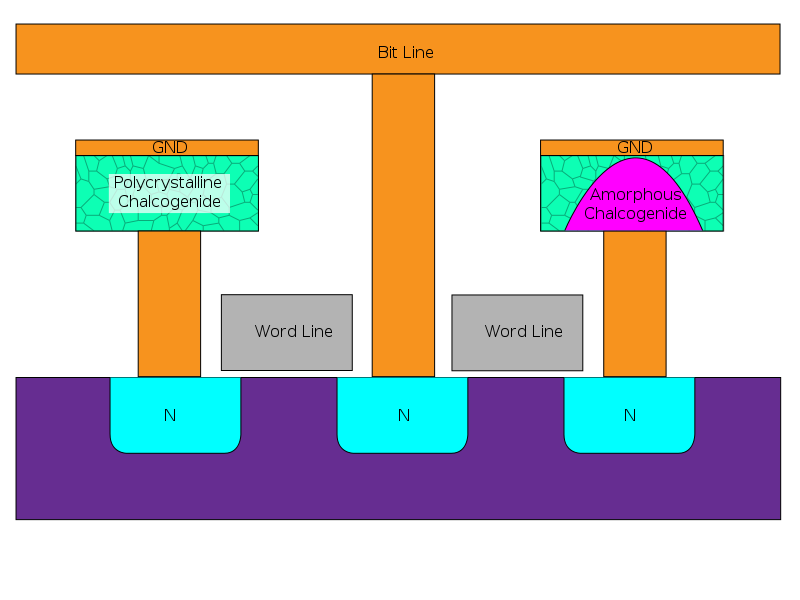Down with sclerosis!
Various technologies from nanocrystals to magnetic memory are considered as a replacement for flash memory, but the developers consider the memory to be the most acceptable technology, the mechanism of which is based on a change in the phase state of a substance.
Previous topic on the topic - "Intel: mass production of PRAM by the end of 2007"
In 2006, Intel, together with STMicroelectronics, demonstrated a memory chip based on a technology that has been worked on for a total of 30 years. The first samples of the chip are called Alverston .
Alverston chips are based on material similar to that used to create optical discs ( chalcogenide glass ), and the principle of operation is based on phase transitions.
For the first time about this technology became known more than 30 years ago, in 1970, when one of the founders of Intel, Gordon Moore , published an article on “Phase-change memory”.

The material is chalcogenide glass (GST), consists of germanium (Ge), antimony (Sb) and tellurium (Te). In the usual (cold) state, the material is an amorphous glassy structure with high electrical resistance (state 1). When exposed to high temperature (up to 600 degrees Celsius), the material crystallizes, it is important to achieve a temperature above the crystallization point, but below the melting point of the material, then the material will have a very low resistance (state 2). As a result of the phase transition, both electrical and optical characteristics (refractive index) change. This transition can take place in less than 5 ns (as of 2006).
In February of this year, Intel announced the development to double the possible capacity of chips based on phase transition technology. Previously, the “phase memory” was implemented by two states (described above), but the researchers showed that there are two more between the amorphous and crystalline states, which can also be used to store information. By adding two bits per cell, Intel together with STMicroelectronics achieved a significant increase in chip performance. Intel has previously mastered a similar flash memory trick in which more than one bit can be stored per memory cell, so a similar step in developing “phase memory” is not surprising.
')
Based on the articles:
Previous topic on the topic - "Intel: mass production of PRAM by the end of 2007"
In 2006, Intel, together with STMicroelectronics, demonstrated a memory chip based on a technology that has been worked on for a total of 30 years. The first samples of the chip are called Alverston .

Alverston chips are based on material similar to that used to create optical discs ( chalcogenide glass ), and the principle of operation is based on phase transitions.
For the first time about this technology became known more than 30 years ago, in 1970, when one of the founders of Intel, Gordon Moore , published an article on “Phase-change memory”.
The principle of "phase memory":

The material is chalcogenide glass (GST), consists of germanium (Ge), antimony (Sb) and tellurium (Te). In the usual (cold) state, the material is an amorphous glassy structure with high electrical resistance (state 1). When exposed to high temperature (up to 600 degrees Celsius), the material crystallizes, it is important to achieve a temperature above the crystallization point, but below the melting point of the material, then the material will have a very low resistance (state 2). As a result of the phase transition, both electrical and optical characteristics (refractive index) change. This transition can take place in less than 5 ns (as of 2006).
State 1 (poorly organized) is used to obtain a low level signal, and state 2 (rigidly structured) a high level signal.
In February of this year, Intel announced the development to double the possible capacity of chips based on phase transition technology. Previously, the “phase memory” was implemented by two states (described above), but the researchers showed that there are two more between the amorphous and crystalline states, which can also be used to store information. By adding two bits per cell, Intel together with STMicroelectronics achieved a significant increase in chip performance. Intel has previously mastered a similar flash memory trick in which more than one bit can be stored per memory cell, so a similar step in developing “phase memory” is not surprising.
The study of “phase memory” has progressed significantly over the past few years, and if a few years ago the transition to mass production did not look promising, now there is not a shadow of doubt about this.
')
The main advantages and differences of the "phase memory":
- using your own physical condition, not electronic charge for storing data,
- possibility of using not only as DRAM and SRAM , but also as non-volatile memory,
- lower power consumption
- the possibility of placing more elements on the crystal,
- high resistance to external influences,
- durability (maintains about 100 million rewriting cycles, and also degenerates more slowly),
- faster write and read speed.
Based on the articles:
Source: https://habr.com/ru/post/23379/
All Articles